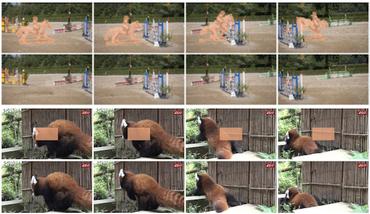Search Results for author: Avisek Lahiri
Found 14 papers, 3 papers with code
Directed Diffusion: Direct Control of Object Placement through Attention Guidance
no code implementations • 25 Feb 2023 • Wan-Duo Kurt Ma, J. P. Lewis, Avisek Lahiri, Thomas Leung, W. Bastiaan Kleijn
Text-guided diffusion models such as DALLE-2, Imagen, eDiff-I, and Stable Diffusion are able to generate an effectively endless variety of images given only a short text prompt describing the desired image content.
LipSync3D: Data-Efficient Learning of Personalized 3D Talking Faces from Video using Pose and Lighting Normalization
no code implementations • CVPR 2021 • Avisek Lahiri, Vivek Kwatra, Christian Frueh, John Lewis, Chris Bregler
In this paper, we present a video-based learning framework for animating personalized 3D talking faces from audio.
Lightweight Modules for Efficient Deep Learning based Image Restoration
1 code implementation • 11 Jul 2020 • Avisek Lahiri, Sourav Bairagya, Sutanu Bera, Siddhant Haldar, Prabir Kumar Biswas
We also present and analyse our results highlighting the drawbacks of applying depthwise separable convolutional kernel (a popular method for efficient classification network) for sub-pixel convolution based upsampling (a popular upsampling strategy for low-level vision applications).
Prior Guided GAN Based Semantic Inpainting
no code implementations • CVPR 2020 • Avisek Lahiri, Arnav Kumar Jain, Sanskar Agrawal, Pabitra Mitra, Prabir Kumar Biswas
Another promising, yet unexplored approach is to first train a generative model to map a latent prior distribution to natural image manifold and during inference time search for the best-matching prior to reconstruct the signal.
The Angel is in the Priors: Improving GAN based Image and Sequence Inpainting with Better Noise and Structural Priors
no code implementations • 16 Aug 2019 • Avisek Lahiri, Arnav Kumar Jain, Prabir Kumar Biswas
To our knowledge, this is the first demonstration of an unsupervised GAN based sequence inpainting.
Faster Unsupervised Semantic Inpainting: A GAN Based Approach
no code implementations • 14 Aug 2019 • Avisek Lahiri, Arnav Kumar Jain, Divyasri Nadendla, Prabir Kumar Biswas
In this paper, we propose to improve the inference speed and visual quality of contemporary baseline of Generative Adversarial Networks (GAN) based unsupervised semantic inpainting.
Improved Techniques for GAN based Facial Inpainting
no code implementations • 20 Oct 2018 • Avisek Lahiri, Arnav Jain, Divyasri Nadendla, Prabir Kumar Biswas
Current benchmark models are susceptible to initial solutions of non-convex optimization criterion of GAN based inpainting.
Unsupervised Domain Adaptation for Learning Eye Gaze from a Million Synthetic Images: An Adversarial Approach
no code implementations • 18 Oct 2018 • Avisek Lahiri, Abhinav Agarwalla, Prabir Kumar Biswas
Such domain difference deteriorates test time performances of models trained on synthetic examples.
Unsupervised Adversarial Visual Level Domain Adaptation for Learning Video Object Detectors from Images
1 code implementation • 4 Oct 2018 • Avisek Lahiri, Charan Reddy, Prabir Kumar Biswas
Though image object detectors have shown rapid progress in recent years with the release of multiple large-scale static image datasets, object detection on videos still remains an open problem due to scarcity of annotated video frames.
Retinal Vessel Segmentation under Extreme Low Annotation: A Generative Adversarial Network Approach
no code implementations • 5 Sep 2018 • Avisek Lahiri, Vineet Jain, Arnab Mondal, Prabir Kumar Biswas
The proposed method is an extension of our previous work with the addition of a new unsupervised adversarial loss and a structured prediction based architecture.
Improving Consistency and Correctness of Sequence Inpainting using Semantically Guided Generative Adversarial Network
1 code implementation • 16 Nov 2017 • Avisek Lahiri, Arnav Jain, Prabir Kumar Biswas, Pabitra Mitra
Contemporary benchmark methods for image inpainting are based on deep generative models and specifically leverage adversarial loss for yielding realistic reconstructions.
Deep Neural Ensemble for Retinal Vessel Segmentation in Fundus Images towards Achieving Label-free Angiography
no code implementations • 19 Sep 2016 • Avisek Lahiri, Abhijit Guha Roy, Debdoot Sheet, Prabir Kumar Biswas
Automated segmentation of retinal blood vessels in label-free fundus images entails a pivotal role in computed aided diagnosis of ophthalmic pathologies, viz., diabetic retinopathy, hypertensive disorders and cardiovascular diseases.
Forward Stagewise Additive Model for Collaborative Multiview Boosting
no code implementations • 5 Aug 2016 • Avisek Lahiri, Biswajit Paria, Prabir Kumar Biswas
Also, the proposed model is compared with traditional boosting and recent multiview boosting algorithms.
WEPSAM: Weakly Pre-Learnt Saliency Model
no code implementations • 3 May 2016 • Avisek Lahiri, Sourya Roy, Anirban Santara, Pabitra Mitra, Prabir Kumar Biswas
Recent thrust in saliency prediction research is to learn high level semantics using ground truth eye fixation datasets.











